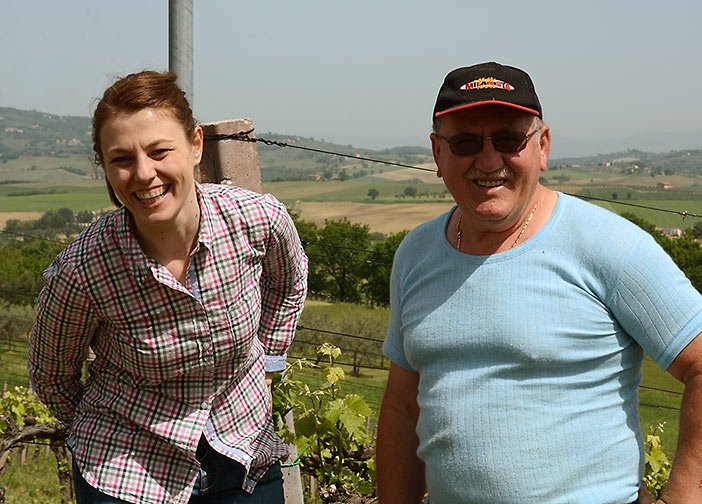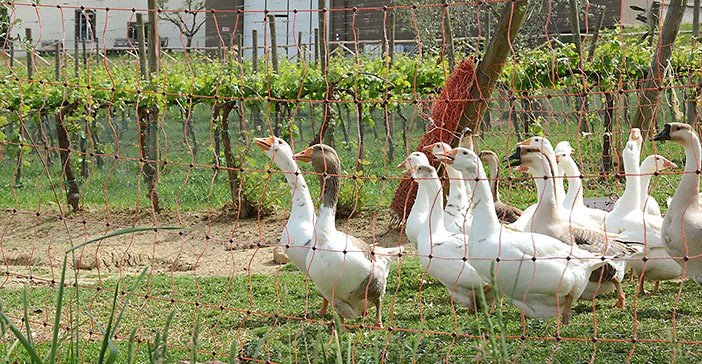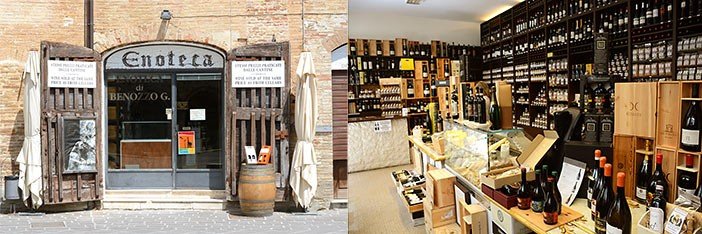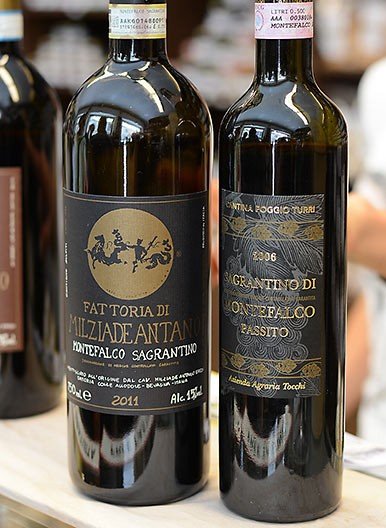From the mountain-fringed province of Umbria in central Italy comes the king of grapes; the tricky, rugged, but gorgeously aging Sagrantino.
Umbria can thank neighboring Tuscany for having magnetically sucked the tourist hordes into itself. Leaving Umbria’s picturesque rolling fields and thousand-year-old hill towns alone. Where in Tuscany you queue up with 200 Texans for the most “authentic Italian food” straight from supermarket, Umbria is full of unique restaurants and trattorias – even without a menu in English or German.

Because of its lower profile, the region’s wines are also spared from overpricing. A fact which is becoming more the rule than the exception with Chianti Classico and Brunello.
I first came into contact with Sagrantino five years ago at the Wine, Food and Good Life fair in Helsinki at Pekka and Sirpa Sipola’s Umbria stand. I was immediately sold. Moretti Omero Montefalco Sagrantino DOCG 2006 was a wine I had never tasted before. Now, years later, I had the opportunity to thank the winemaker himself and to get to know this unique grape in more detail.
Sagrantino is like a young man
Omero Moretti’s daughter Giusy Moretti summed up Sagrantino’s upbringing descriptively:Sagrantino is like a young man; feisty, full of energy and almost impossible to control. Very challenging to breed to produce quality – but worth the effort!
The cane has the highest phenol content in the world, according to scientists. Sagrantino is also one of the most tannic grapes in the world. Thanks to its tannins, Sagrantino has almost unlimited ageing potential, which is not yet even half understood. It has only been grown for commercial purposes since the 1960s, so it is still early days in terms of discovering the grape’s properties.
Sagrantino was separated from Montefalco DOC, which was born in 1979, to become its own Sagrantino di Montefalco DOCG in 1992. Because of its reputation for being difficult to grow, the grape is grown by only 25 vineyards on a total of 100 hectares on the outskirts of the hill town of Montefalco. Outside Umbria, the grape is being tested in California and Australia.
Sagrantino di Montefalco DOCG quality classification
- 100% Sagrantino
- Dry and sweet (Passito)
- Minimum 13% alcohol
- Matured for 30 months, including at least 12 months in wooden barrels (dry wine, passito does not need to be aged in barrels).
- Acids minimum 5g/litre
The origin of sagrantino is unknown. Some believe it was grown in Umbria from the beginning of time, others think it came to the country closer to a thousand years ago as a gift from Franciscans from some far-off land where monks had been preaching.

During the growing season, the vines leaf out profusely and need to be thinned almost weekly. The variety does not mature until October, often in the second half of the year, when the dense clumps are easily mouldy in the rains. The thick-skinned grapes contain a lot of seeds and care must be taken not to break them in the cellar – this would make the already very tannic wine sandpaper.
Sagrantino wines are deep purple in colour, even impenetrable black. The aromas are of blackberries, dark cherry, vanilla, chocolate and liquorice. Sweet Passito wines even produce blueberry aromas. Full-bodied or very full-bodied wines are dark fruity, intense, long and mouth-drying tannic when young. However, the tannins quickly start to soften, as evidenced by the 2007 Moretti Omero Sagrantino I tasted earlier this year, which was already quite velvety.
Moretti Omero – for the love of Sagrantino
Omero Moretti is the gentleman I have to thank for my enthusiasm for this tricky but rewarding wine. The family farm grows a few varieties of grapes, as well as olives for oil production. A generational change is underway and daughter Giusy Moretti is taking on more and more responsibility for the products. Her Nessuno white wine is a stunning example of the talents of a young and energetic woman.

- Organic since 1992
- 30 hectares, 13 hectares under vine
- 75,000 bottles of wine per year
- 40% exported to USA, Holland and Poland.
- 400 meters above sea level
From mid-October onwards, the farm is a busy time of ramping between field and house. The hand-picked grapes spend a maximum of two hours on the tractor’s platform and then on to the belt, thus preserving as clean a taste as possible. The yield is between 25 and 30 hectoliters per hectare.The Sagrantino is matured in new 550 litre double barriques. The oak is usually French, but American oak is also being tested.
Moretti Omero wine tasting
Moretti Omero Montefalco Sagrantino DOCG 2007
An attractive nose of dark cherries, vanilla, bearberry jam. Lively, delicious and full-bodied wine. Long aftertaste with fair tannins.
Moretti Omero Montefalco Sagrantino DOCG 2010
Cherries, blackberry jam. Full-bodied and energetic. A more elegant vintage that requires ageing.
Montefalco Sagrantino Vignalunga DOCG 2010
Complex nose; currants, smoke, spices and chocolate.
Powerful, intense, fresh, deep and tannic. Years more in the cellar and the bank will explode.
www.morettiomero.it
See also the fun video recipes produced by the farm here!
Di Filippo – hands deep in the ground
In the heart of Umbria, with the historic city of Assisi standing guard in the background, lies Di Filippo’s 30-hectare organic and Biodynamic winery. Roberto di Filippo leaves no stone untouched in his quest to develop more environmentally friendly viticulture methods. The plots are dotted with row fields of soil-enhancing plants such as herbs, chickpeas and lentils, which help regulate soil nitrogen levels, among other things. Organic fertilizers are applied by geese, and for heavier work there are a few horses, whose use has been learned from the Amish, known in America for their old-fashioned, nature-respecting lifestyle.


Roberto is passionate about studying vine pruning techniques for different grape varieties and their impact on the taste of wine. He is equally enthusiastic about natural yeasts, but apart from the Sangiovese, his experiments have not yet been very successful. The farm grows grapes typical of the region; Sangiovese; Cabernet Sauvignon; Merlot; Barbera; Cornetta (aka Vernaccia Nera); Grechetto; Trebbiano Spoletino, but Sagrantino is their pride and joy – and for good reason.
Di Filippo wine tasting

Di Filippo Montefalco Sagrantino Etnico 2011
Powerfully fruity nose. Dark berries. The palate is lively and fruity, full-bodied and long. Fair but velvety tannins.
Di Filippo Montefalco Sagrantino 2011
Intense nose with a hint of dark and red berries. Full-bodied, but lively and quite elegant wine. Long finish and great tannins.
Di Filippo Montefalco Sagrantino Passito 2008
Intense and complex nose of blackberry jam and red berries. Broadly fruity and sweet. Velvety mouthfeel and sweet tannins at the end hold the package together nicely.
vinidifilippo.com
Montefalco wine shops

Montefalco is the wine town of Umbria. Apart from the gruesome-looking water tower, the historic and beautiful little town with its narrow alleys and piazzas is immediately captivating. The town is full of excellent restaurants, cafés and wine shops – enotecas where you can make interesting bargains.

Antonelli montefalco sagrantino 2007
Cherries, blackberries and red berries on the elegant nose.
A velvety, balanced and lively wine. Full-bodied and elegant. Fair tannins nicely integrated into the wine. With food, it became a stunningly wonderful experience.
Colpetrone montefalco sagrantino 2005
Deep aromas of plum and ripe cherries. Leather and vanilla. Superbly developed.
Full-bodied and berry-like velvety. Fair tannin already melted into the wine. A fine presentation. Tasted also without food.

Fattoria Milziade Antano Montefalco Sagrantino D.O.C.G 2011
Black cherries, marzipan and a touch of smoke. Elegant, acidic, salon-like, balanced with soft tannins. A really great Sagrantino to drink young.
Fattoria Milziade Antano Montefalco Sagrantino Passito D.O.C.G 2006
Bearish, balanced and sweet. But not so sweet that you can’t taste it with a lamb roast, for example.
Text and photos: Janne Suomi
Last Updated on June 5, 2022 by Flavorado
This post is also available in:
Suomi

